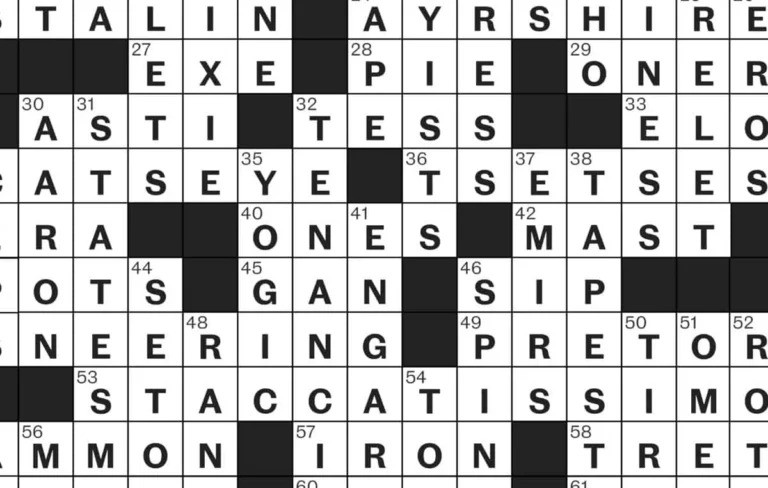
If you’ve ever found yourself deeply immersed in the crossword puzzle from The New York Times, frantically filling in squares, wracking your brain for the perfect word, only to end up utterly exhausted, you’re not alone. The NYT crossword is renowned for its challenging clues, wordplay, and clever constructions that engage and sometimes baffle even the most seasoned solvers. In this comprehensive guide, we’ll delve into the fascinating world of the utterly exhausted NYT crossword, exploring its history, types of clues, strategies for solving, and the unique experience it offers to word enthusiasts.
Table of Contents
ToggleThe Evolution of the NYT Crossword Puzzle
The crossword puzzle has a rich history that dates back to the late 19th century. However, it wasn’t until the early 20th century that it gained widespread popularity. The New York Times, a prominent American newspaper, began featuring crosswords in its Sunday edition in 1942, setting the stage for a puzzle revolution. Since then, the NYT crossword has become an iconic representation of the genre, known for its quality, wit, and, of course, its ability to leave solvers utterly exhausted.
Crossword Games A Mind Exercise
Engaging in crossword puzzles is not merely a pastime; it’s a mental workout. The process of solving a crossword involves more than just filling in blanks – it requires a diverse set of skills, from word recognition to deductive reasoning and a healthy dose of creativity. Each puzzle is a unique challenge, designed to stretch your linguistic prowess and keep your mind sharp. Whether you’re a seasoned veteran or a crossword novice, the utterly exhausted NYT crossword promises an experience like no other.
Decoding the Puzzle Types of Clues
One of the distinguishing features of the NYT crossword is the variety of clues it presents. From straightforward definitions to cryptic wordplay, each clue is meticulously crafted to challenge and entertain solvers. Some common types of clues include anagrams, homophones, hidden words, and puns. The utterly exhausted NYT crossword often combines these types, creating a formidable puzzle that demands not just a robust vocabulary but also a keen sense of linguistic nuance.
Crossword Puzzle Strategies A Solving Guide
Tackling the utterly exhausted NYT crossword requires more than just a love for words; it demands a strategic approach. Seasoned crossword solvers develop a set of skills and strategies that help them navigate the twists and turns of each puzzle. Start with the easy clues to fill in the blanks, then work your way through the more challenging ones. Pay attention to the crossings – where words intersect – as they provide valuable hints. Familiarize yourself with common crossword abbreviations and crosswordese – words frequently used in puzzles but seldom in everyday conversation.
Wordplay and Innovation The NYT Crossword Experience
What sets the utterly exhausted NYT crossword apart is its commitment to innovation and wordplay. The puzzle creators, often referred to as constructors, continually push the boundaries of what a crossword can be. The clues are crafted with meticulous precision, combining clever wordplay, cultural references, and a touch of humor. Solving an NYT crossword isn’t just about completing a grid; it’s an adventure that takes you through a linguistic landscape, challenging your knowledge and wit at every turn.
The Role of Crossword Solvers
Crossword enthusiasts, or solvers, play a crucial role in the life of the utterly exhausted NYT crossword. Their dedication and passion drive the puzzle popularity, making it a beloved tradition for many. Online communities and forums provide solvers with a platform to discuss clues, share strategies, and celebrate the thrill of conquering a particularly challenging puzzle. The sense of camaraderie among solvers adds another layer to the crossword experience, turning it into a shared journey of words and wit.
The Crossword Puzzle in Popular Culture
The NYT crossword has transcended the realm of newspapers, finding its way into popular culture. References to the puzzle appear in literature, movies, and television shows, further cementing its status as an intellectual and cultural phenomenon. The utterly exhausted NYT crossword has become a symbol of mental agility, inspiring and challenging minds across generations.
British vs. American Crossword Puzzles
While the NYT crossword is a quintessentially American institution, it’s essential to acknowledge the rich tradition of crossword puzzles in other parts of the world. British crossword puzzles, for example, have their own set of conventions and quirks. The British cryptic crossword, in particular, is renowned for its elaborate wordplay and linguistic acrobatics. Exploring the differences between British and American crossword puzzles provides solvers with a broader perspective and a deeper appreciation for the art of constructing and solving.
Resources for Crossword Enthusiasts
For those looking to dive deeper into the world of crossword puzzles, there are abundant resources available. The New York Times offers a dedicated crossword section on its website, where solvers can access daily puzzles, archives, and even compete against the clock. Crossword apps and puzzle books provide additional opportunities to hone your skills and enjoy the challenge at your own pace. Whether you prefer the tactile feel of a newspaper or the convenience of a digital platform, there’s a wealth of crossword content waiting to be explored.
Conclusion
In the realm of word games the utterly exhausted NYT crossword stands as a beacon of intellectual stimulation and linguistic creativity. Its rich history, diverse clues, and innovative constructions make it a beloved pastime for countless enthusiasts. As you embark on your crossword-solving journey, armed with strategies and a passion for words, remember that each puzzle is a unique experience. Embrace the challenge, revel in the wordplay, and join the community of solvers who find joy in the delightful exhaustion that comes from conquering the New York Times crossword.



